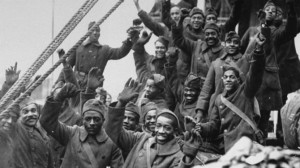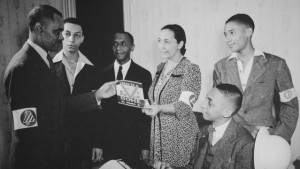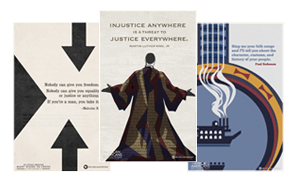Who Were the Harlem Hellfighters?
Harlem Hellfighters Homecoming Parade
“Up the wide avenue they swung. Their smiles outshone the golden sunlight. In every line proud chests expanded beneath the medals valor had won. The impassioned cheering of the crowds massed along the way drowned the blaring cadence of their former jazz band. The old 15th was on parade and New York turned out to tender its dark-skinned heroes a New York welcome.”
So began the three-page spread the New York Tribune ran Feb. 18, 1919, a day after 3,000 veterans of the 369th Infantry (formerly the 15th New York (Colored) Regiment) paraded up from Fifth Avenue at 23rd Street to 145th and Lenox. One of the few black combat regiments in World War I, they’d earned the prestigious Croix de Guerre from the French army under which they’d served for six months of “brave and bitter fighting.” Their nickname they’d received from their German foes: “Hellfighters,” the Harlem Hellfighters.
In their ranks was one of the Great War’s greatest heroes, Pvt. Henry Johnson of Albany, N.Y., who, though riding in a car for the wounded, was so moved by the outpouring he stood up waving the bouquet of flowers he’d been handed. It would take another 77 years for Johnson to receive an official Purple Heart from his own government, but on this day, not even the steel plate in his foot could weigh him down.
It was, the newspapers noted, the first opportunity the City of New York had to greet a full regiment of returning doughboys, black or white. The Chicago Defender put the crowd at 2 million, the New York Tribune at 5 million, with even the New York Times conservatively estimating it at “hundreds of thousands.”
“Never have white Americans accorded so heartfelt and hearty a reception to a contingent of their black country-men,” the Tribune continued. And “the ebony warriors” felt it, literally, beneath a hail of chocolate candy, cigarettes and coins raining down on them from open windows up and down the avenues. It would have been hard to miss them, at least according to the New York Times, to whom all the men appeared 7 feet tall.
Yet as rousing as those well-wishers were, the Tribune pointed out, “the greeting the regiment received along Fifth Avenue was to the tumult which greeted it in Harlem as the west wind to a tornado.” After all, 70 percent of the 369th called Harlem home, and their families, friends and neighbors had turned out in full force to thank and welcome those who’d made it back. Eight hundred hadn’t, an absence recalled in the number of handkerchiefs drying wet eyes.
That morning, it had taken four trains and two ferries to transport the black veterans and their white officers from Camp Upton on Long Island to Manhattan, and the parade, kicking off at 11:00 a.m.—an echo of the armistice that had halted the fighting three months before—stretched seven miles long. In his 1845 slave narrative, Frederick Douglass had likened his master to a snake; now a rattlesnake adorned the black veterans’ uniforms—their insignia. On hand to greet them was a host of dignitaries, including the African-American leader Emmett Scott, special adjutant to the secretary of war; William Randolph Hearst; and New York’s popular Irish Catholic governor, Al Smith, who reviewed his Hellfighters from a pair of stands on 60th and 133rd Streets.
In Harlem, the Chicago Defender observed, Feb. 17, 1919, was an unofficial holiday, with black school children granted dismissal by the board of education. A similar greeting—on the same day, in fact—met the returning black veterans of the 370th Infantry (the old Eighth Illinois) in Chicago, Chad L. Williams writes in his 2010 book, Torchbearers of Democracy: African American Soldiers in the World War I Era. And in the coming months, there would be other celebrations, even in the Jim Crow South, most notably Savannah, Ga., the state that in 1917 and 1918 led the nation in lynchings, according to statistics published by the Tuskegee Institute. It was, to be sure, a singular season, a pause between the end of hostilities abroad and the resumption of hostilities at home in a nation still divided so starkly, so violently, by the color line.
Congress would not make Armistice Day an official U.S. holiday until 1938, and it would not be called Veterans Day until 1954. But the people of New York didn’t need Congress to tell them what to do when their black fighting men returned home, and so you might say, the first “veterans day parade” in New York associated with “Armistice Day” was held for black soldiers on Feb. 17, 1919, during the month that would eventually be set aside for black history.
Blacks Debate the War Effort
Two years before, on April 2, 1917, President Woodrow Wilson asked Congress for a declaration of war in order to enter a conflict between European powers that had started over the assassination of an archduke in 1914. “The World must be made safe for democracy,” the president said. The nation’s allies: the British, French and Russians. Its enemies: Germany, Italy, Austria-Hungary, the so-called Central Powers.
For some African Americans, Wilson’s rhetoric smacked of hypocrisy. After all, he was the president who had screened Birth of a Nation (a film glorifying the Ku Klux Klan) at the White House and refused to support a federal anti-lynching bill, even though each year averaged more than one lynching a week, predominantly in former Confederate states that had effectively stripped black men of their voting rights. “Will some one tell us just how long Mr. Wilson has been a convert to TRUE DEMOCRACY?” the Baltimore Afro-American editorialized on April 28, 1917 (quoted in Williams). “Patriotism has no appeal for us; justice has,” the Messenger, a Socialist publication launched by editors Chandler Owen and A. Philip Randolph (of March on Washington fame), declared on Nov. 1, 1917—a sentiment that would land both men in jail under the Espionage Act in 1918 (quoted in Adriane Lentz-Smith’s 2009 book, Freedom Struggles: African Americans and World War I).
Many more blacks viewed the war as an opportunity for victory at home and abroad. W.E.B. Du Bois, a founder of the NAACP in 1909, urged his fellow African Americans to “Close Ranks” in a (now infamous) piece he wrote for the Crisis in July 1918, despite the persistent segregation of black officers at training camp. “Let us, while this war lasts, forget our special grievances and close our ranks shoulder to shoulder with our white fellow citizens and the allied nations that are fighting for democracy,” Du Bois advised—a stance, Williams notes, that would stir controversy when Du Bois was exposed for making simultaneous “efforts to secure a captaincy” for himself.
In all, Williams writes, “2.3 million blacks registered [for the draft]” during World War I. Although the Marines would not accept them, and the Navy enlisted few and only in menial positions, large numbers served in the army. Some 375,000 blacks served overall, including “639 men [who] received commissions, a historical first,” Williams adds in his essay “African Americans and World War I.”
Wartime Violence
The U.S. Army segregated its black troops into two combat divisions, the 92nd and the 93rd, because, as Williams explains, “War planners deemed racial segregation, just as in civilian life, the most logical and efficient way of managing the presence of African Americans in the army.”
But a different kind of violence soon spread—at home, most notably in East St. Louis, where, on July 2, 1917, the rumor that a black man had killed a white man resulted in the murder of nine whites and hundreds of blacks, not to mention half a million dollars in property damage. Things weren’t much better in the South. On August 23, 1917, black soldiers in the 24th Infantry garrisoned in Houston revolted when one of their comrades was beaten and arrested by two white police officers after he tried to stop them from arresting a black woman. Quickly, rumors flew that a white mob was approaching the camp, which, whether true or not, prompted the black troops to scour the camp for ammunition under the notion that the best defense is a good offense.
Marching through the rain to Houston, they killed 15 people, including four policemen and a member of the Illinois National Guard. Two of the black soldiers died in the fighting, one shooting himself in the head rather than risking capture. “Ten men probably ‘could not begin to tell the complete story of what took place that night,’ ” Lentz-Smith quotes “Army prosecutor Colonel Hull,” yet in the fallout, “[t]hey charged 63 members of the battalion with mutiny,” and hanged 13 in “their army khakis.”
‘Over There!’
Of the 375,000 blacks who served in World War I, 200,000 shipped out overseas, but even in the theater of war, few saw combat. Most suffered through backbreaking labor in noncombat service units as part of the Services of Supply. Lentz-Smith puts the number of combat troops at 42,000, only 11 percent of all blacks in the army.
For the first of the two black combat divisions, the 92nd, the Great War was a nightmare. Not only were they segregated, their leaders scapegoated them for the American Expeditionary Forces’ failure at Meuse-Argonne in 1918, even though troops from both races struggled during the campaign. In the aftermath, five black officers were court-martialed on trumped-up charges, with white Major J. N. Merrill of the 368th’s First Battalion writing his superior officer, “Without my presence or that of any other white officer right on the firing line I am absolutely positive that not a single colored officer would have advanced with his men. The cowardice showed by the men was abject” (quoted in Williams, Torchbearers). Even though Secretary of War Newton Baker eventually commuted the officers’ sentences, the damage was done: The 92nd was off the line.
Read more of this blog post on The Root.
Fifty of the 100 Amazing Facts will be published on The African Americans: Many Rivers to Cross website. Read all 100 Facts on The Root.
Find educational resources related to this program - and access to thousands of curriculum-targeted digital resources for the classroom at PBS LearningMedia.
Visit PBS Learning Media








